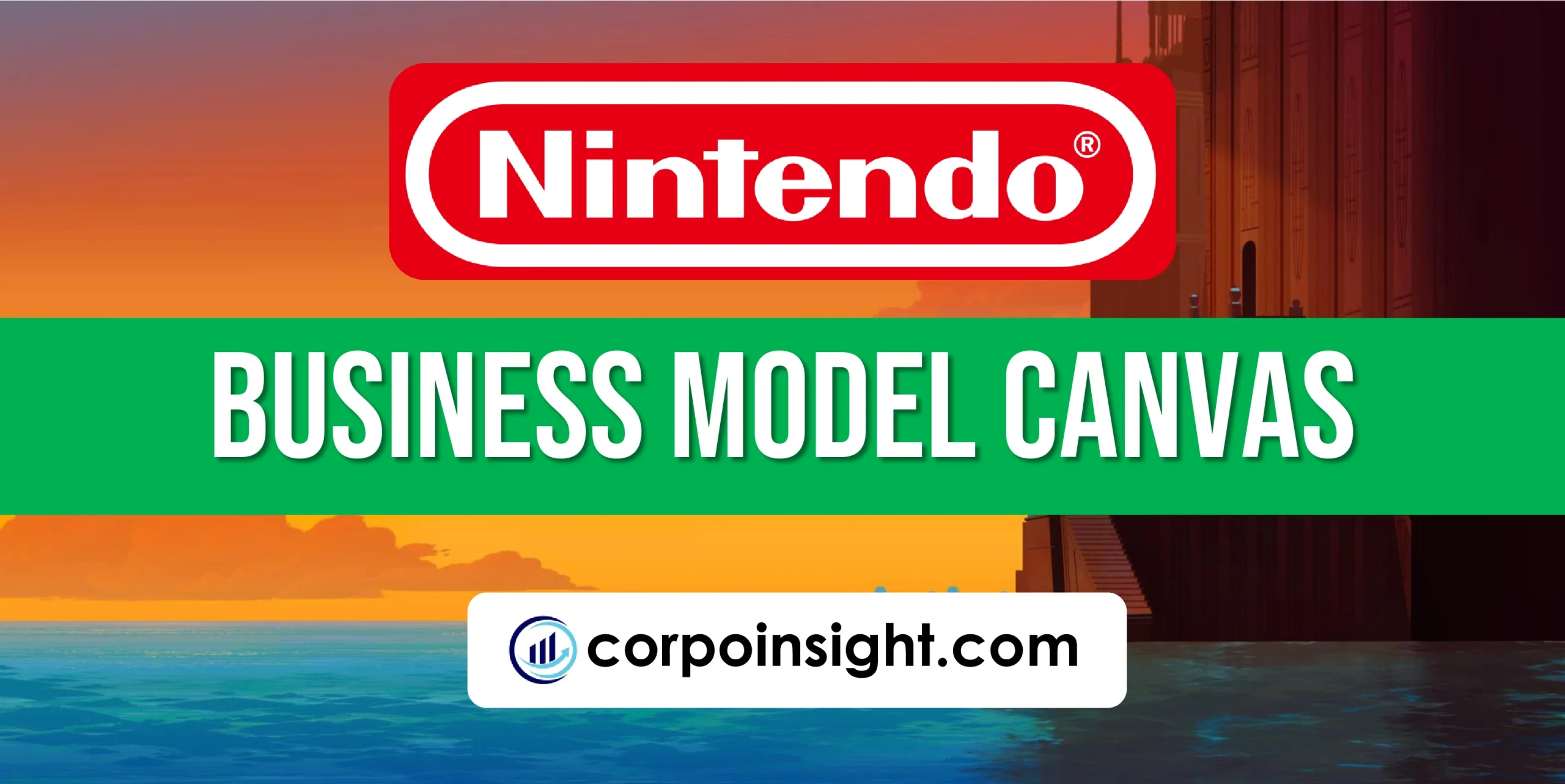Nintendo Business Model Canvas 2024
Although Nintendo began as a humble playing card company in 1889, it evolved into a revolutionary gaming force that has brought billions of joy through iconic franchises like Mario, Zelda, and Pokémon. In this Nintendo Business Model Canvas, I will identify its customer segments, value proposition, revenue streams, channels, customer relationships, key activities, key resources, key partners, and cost structure.
Interesting fact!
Nintendo’s first electronic product wasn’t a game – it was a vacuum cleaner called “Chiritory” in 1971, designed by Gunpei Yokoi, who later created the Game Boy.
Nintendo Competitors
Sony PlayStation | Microsoft Xbox | Valve (Steam) | Tencent Games | Apple (Mobile Gaming) | Meta/Oculus | Google (Stadia/Play Store) | SEGA | Nvidia (GeForce Now) | Electronic Arts
Customer Segments – Nintendo Business Model Canvas
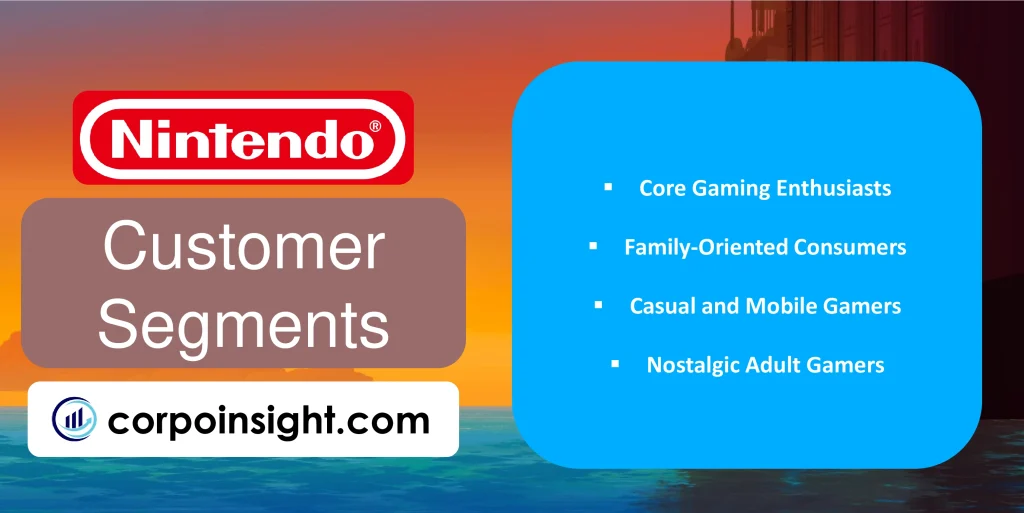
Core Gaming Enthusiasts: While maintaining a dedicated following among traditional gamers through franchises like The Legend of Zelda: Tears of the Kingdom (2023), which sold 18.5M copies, Nintendo has cultivated a unique segment of players who prioritize innovative gameplay over cutting-edge graphics.
Family-Oriented Consumers: Through the Nintendo Switch’s versatility and family-friendly titles like Mario Kart 8 Deluxe (which reached 57M sales by 2023), Nintendo dominates the household entertainment segment, attracting parents who seek wholesome, multiplayer experiences for their children.
Casual and Mobile Gamers: By leveraging mobile adaptations of popular franchises like Mario Kart Tour and Animal Crossing: Pocket Camp, Nintendo has successfully penetrated the casual gaming market, accumulating over 800M mobile downloads and $1.8B in revenue by 2023.
Nostalgic Adult Gamers: Through strategic releases of retro content via Nintendo Switch Online and remakes like Super Mario RPG (2023), Nintendo effectively targets adults aged 25-40 who grew up with their classic systems and seek to relive their gaming memories.
Value Proposition – Nintendo Business Model Canvas
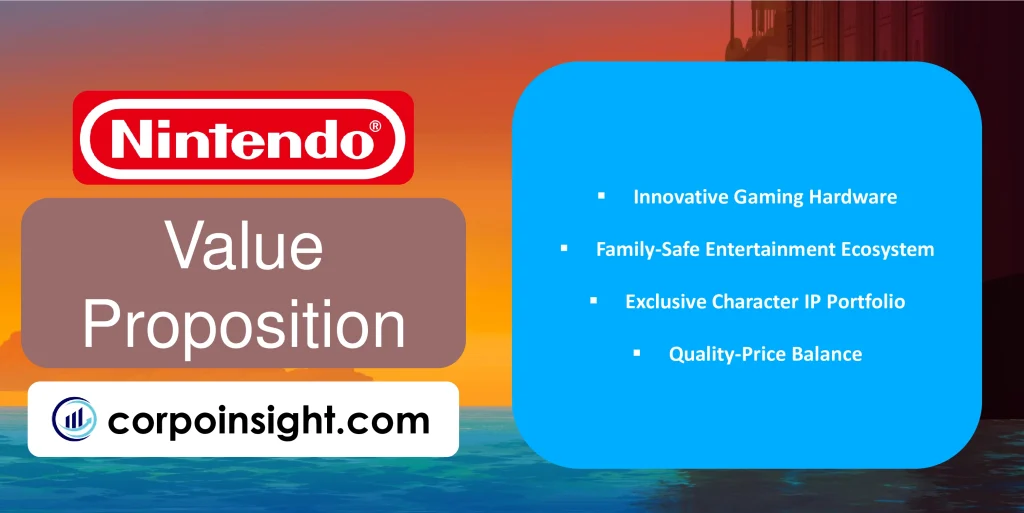
Innovative Gaming Hardware: By introducing the hybrid Nintendo Switch system, which has sold over 132M units by 2023, Nintendo offers unparalleled versatility through seamless transitions between handheld and TV-connected gaming, revolutionizing how and where players engage with content.
Family-Safe Entertainment Ecosystem: While maintaining strict content guidelines and comprehensive parental controls, Nintendo distinguishes itself by delivering consistently high-quality, non-violent entertainment options, resulting in 97% of its games receiving E or E10+ ratings by 2023.
Exclusive Character IP Portfolio: Through carefully curated intellectual properties like Mario, whose games have collectively sold over 800M units, Nintendo offers unique gaming experiences that cannot be replicated elsewhere, fostering brand loyalty and cultural significance across generations.
Quality-Price Balance: Despite industry trends toward higher pricing and microtransactions, Nintendo maintains a consumer-friendly approach by offering premium gaming experiences at $59.99, while their first-party titles retain value remarkably well in the secondary market.
Revenue Streams – Nintendo Business Model Canvas
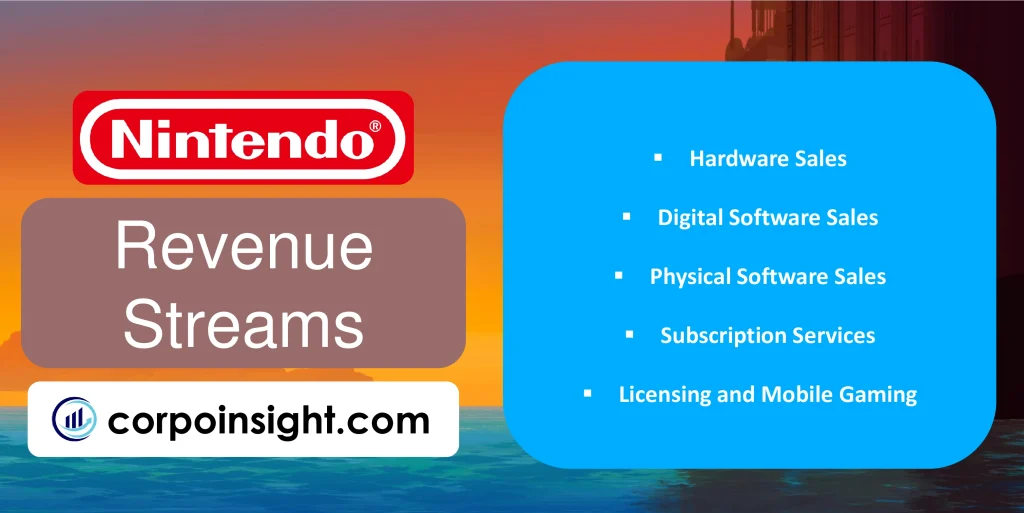
Hardware Sales: Through the continued success of the Nintendo Switch family of systems, which generated ¥389.3 billion ($2.6B) in hardware sales during the first three quarters of 2023, Nintendo maintains a robust primary revenue stream despite the console entering its seventh year.
Digital Software Sales: While transitioning towards digital distribution, Nintendo’s eShop revenue reached ¥359.6 billion ($2.4B) in 2023, representing a significant 14.7% year-over-year increase through both first-party titles and third-party developer contributions on their platform.
Physical Software Sales: Although digital sales are growing, physical game sales remain substantial at ¥733.8 billion ($4.9B) in 2023, as Nintendo leverages its strong retail partnerships and consumers’ preference for tangible game ownership, particularly in the Japanese market.
Subscription Services: Through Nintendo Switch Online, which surpassed 36 million subscribers in 2023 at $19.99/year for basic and $49.99/year for expansion pack memberships, Nintendo has established a consistent recurring revenue stream while offering classic games and online functionality.
Licensing and Mobile Gaming: By strategically partnering with mobile developers and merchandising licensees, Nintendo generated approximately ¥100 billion ($670M) in 2023 through mobile games like Mario Kart Tour and royalties from products featuring their intellectual property.
Channels – Nintendo Business Model Canvas
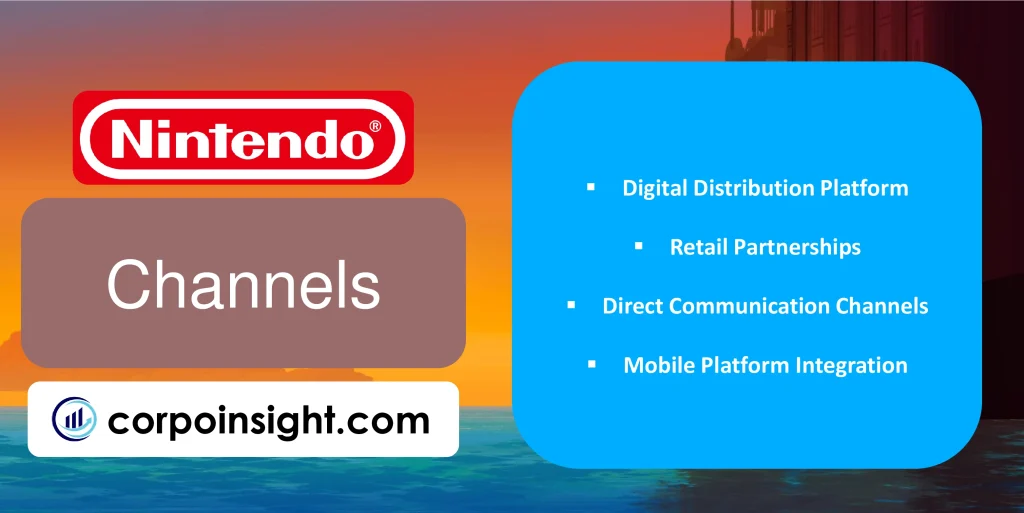
Digital Distribution Platform: Through the Nintendo eShop, which processed over 531 million software downloads in 2023, Nintendo provides instant game delivery while maintaining complete control over pricing, promotions, and user data, resulting in higher profit margins compared to physical sales.
Retail Partnerships: While collaborating with major retailers like GameStop, Target, and Amazon, Nintendo maintains a strong brick-and-mortar presence through dedicated gaming sections and exclusive retail promotions, which contributed to 53% of their total sales remaining physical in 2023.
Direct Communication Channels: Through Nintendo Direct presentations, which garnered over 40 million views per showcase in 2023, and their social media presence exceeding 50 million followers across platforms, Nintendo effectively communicates product announcements and maintains community engagement.
Mobile Platform Integration: Despite being selective with mobile releases, Nintendo leverages App Store and Google Play platforms to distribute mobile titles like Mario Kart Tour and Animal Crossing: Pocket Camp, which collectively reached over 800 million downloads by 2023.
Customer Relationships – Nintendo Business Model Canvas

Community Building and Engagement: Through Nintendo Switch Online’s expanding community features and events like the Mario Kart 8 Deluxe Online Tournaments, which hosted over 10 million players in 2023, Nintendo fosters strong player connections while maintaining a safe, moderated gaming environment.
Customer Support Excellence: While operating multiple support channels, including their award-winning customer service department that maintains a 94% satisfaction rate in 2023, Nintendo demonstrates a commitment to player assistance through comprehensive warranty programs and repair services across global markets.
Loyalty Programs and Rewards: Through the My Nintendo rewards program, which surpassed 200 million members in 2023, Nintendo incentivizes continued engagement by offering exclusive digital rewards, physical merchandise, and platinum points that can be redeemed for special in-game content.
Direct Player Communication: By leveraging Nintendo Direct presentations and active social media engagement, generating over 500 million impressions per quarter in 2023, Nintendo maintains transparent, two-way communication with its customer base while building anticipation for upcoming releases.
Key Activities – Nintendo Business Model Canvas
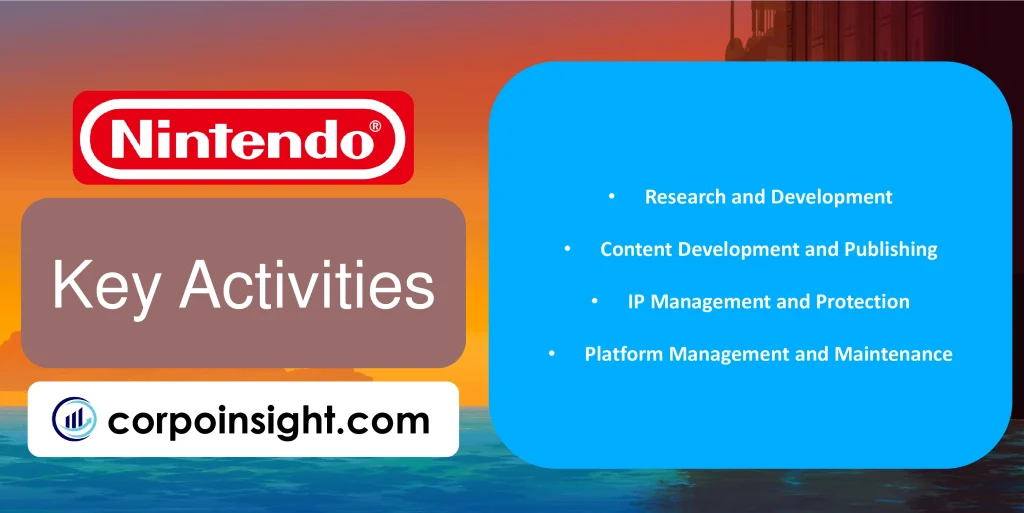
Research and Development: Through substantial investment in innovative gaming technologies, evidenced by their ¥100 billion ($670M) R&D budget in 2023, Nintendo consistently develops groundbreaking hardware and software solutions, as demonstrated by their upcoming next-generation console development and advanced gaming features.
Content Development and Publishing: While maintaining strict quality standards, Nintendo’s first-party development studios produced several critically acclaimed titles in 2023, including The Legend of Zelda: Tears of the Kingdom and Super Mario Bros. Wonder, which collectively sold over 30M copies.
IP Management and Protection: Through vigilant protection of its intellectual property portfolio, which spans over 5,000 registered trademarks globally, Nintendo aggressively defends its characters and brands while strategically licensing content for various entertainment mediums, including the successful Super Mario Bros. Movie.
Platform Management and Maintenance: By continuously updating and maintaining the Nintendo Switch ecosystem, which serves over 132 million users globally, Nintendo ensures platform stability, security, and feature enhancement through regular system updates and eShop curation.
Key Resources – Nintendo Business Model Canvas

Intellectual Property Portfolio: Through decades of development, Nintendo has amassed an invaluable collection of iconic franchises, including Mario, which alone has generated over $30 billion in revenue, while The Legend of Zelda and Pokémon franchises continue driving substantial growth through merchandising and licensing.
Technical Infrastructure: While maintaining robust global servers that support over 36 million Nintendo Switch Online subscribers and processing millions of daily eShop transactions, Nintendo’s technological backbone ensures seamless gaming experiences across their digital ecosystem, backed by significant data centers worldwide.
Financial Resources: Through conservative financial management, Nintendo maintains a strong balance sheet with approximately ¥2.7 trillion ($18B) in cash reserves as of 2023, enabling strategic investments in R&D and acquisitions while weathering market fluctuations.
Development Studios: By nurturing internal development teams and maintaining strategic partnerships with studios like HAL Laboratory and Game Freak, Nintendo consistently delivers high-quality content through a network of over 5,000 dedicated developers and creative professionals.
Manufacturing Capabilities: Through established relationships with key suppliers and manufacturing partners, primarily in Asia, Nintendo maintains efficient production capabilities that delivered over 132 million Switch units despite global supply chain challenges.
Key Partners – Nintendo Business Model Canvas
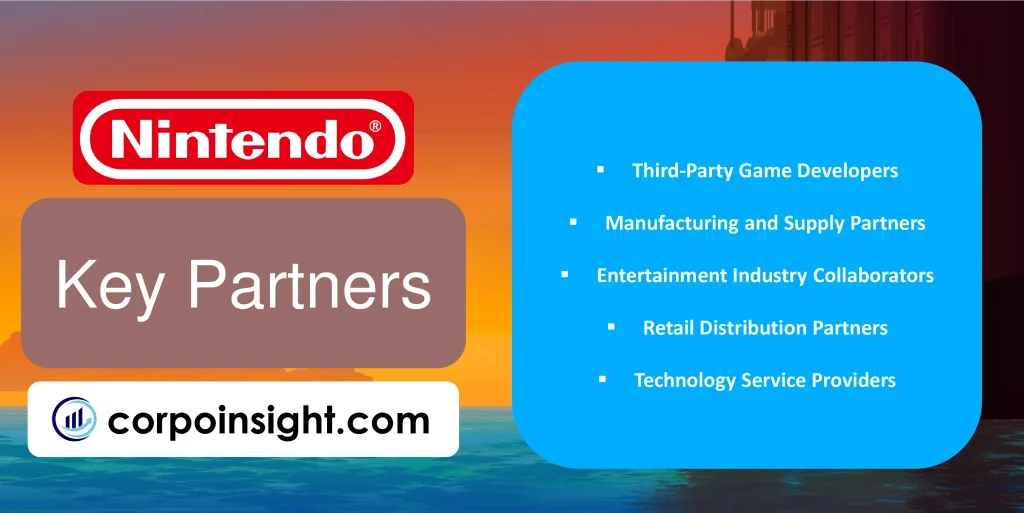
Third-Party Game Developers: Through strategic collaborations with major developers like Square Enix, Capcom, and Atlus, which collectively contributed to over 4,000 games on the Nintendo Switch by 2023, Nintendo maintains a diverse software ecosystem while securing platform-exclusive content and timed releases.
Manufacturing and Supply Partners: While maintaining crucial partnerships with NVIDIA for custom Tegra processors and with manufacturers like Foxconn and Hosiden, Nintendo ensures consistent hardware production capacity, which enabled them to manufacture over 20 million Switch units in 2023 despite ongoing chip shortages.
Entertainment Industry Collaborators: Through successful partnerships with Universal Studios (Super Nintendo World theme parks) and Illumination (The Super Mario Bros. Movie, grossing $1.36B), Nintendo has significantly expanded its brand presence beyond gaming while maintaining creative control.
Retail Distribution Partners: By fostering relationships with major retailers like GameStop, Amazon, and Walmart, alongside regional distributors worldwide, Nintendo maintains a robust physical presence that contributed to over 50% of their total sales in 2023, ensuring broad market accessibility.
Technology Service Providers: Through partnerships with cloud service providers and online infrastructure companies, Nintendo delivers stable online gaming services to their 36 million Nintendo Switch Online subscribers while expanding their cloud gaming capabilities and digital distribution network.
Cost Structure – Nintendo Business Model Canvas
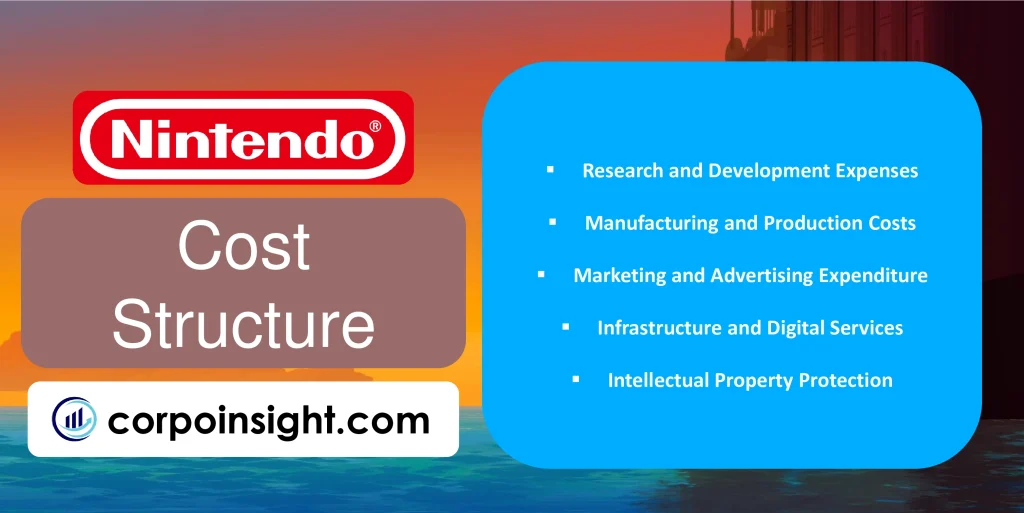
Research and Development Expenses: While investing heavily in innovation, Nintendo allocated approximately ¥100 billion ($670M) to R&D in 2023, encompassing both hardware development for their next-generation console and software creation, which represents roughly 15% of their operating expenses.
Manufacturing and Production Costs: Through strategic component procurement and manufacturing partnerships, Nintendo’s cost of goods sold reached ¥800 billion ($5.4B) in 2023, primarily driven by Switch hardware production, physical game manufacturing, and supply chain management expenses.
Marketing and Advertising Expenditure: While maintaining its family-friendly brand image, Nintendo invested approximately ¥200 billion ($1.3B) in marketing activities during 2023, including Nintendo Direct productions, global advertising campaigns, and promotional partnerships with retailers and media outlets.
Infrastructure and Digital Services: Through continuous investment in online services infrastructure, including server maintenance, eShop operations, and Nintendo Switch Online platform support, Nintendo allocates approximately ¥150 billion ($1B) annually to maintain its digital ecosystem.
Intellectual Property Protection: By actively defending its valuable IP portfolio through legal actions and trademark protection, Nintendo invests significantly in legal resources and anti-piracy measures, with annual expenditures exceeding ¥50 billion ($335M) in 2023.
Summary of Nintendo Business Model Canvas
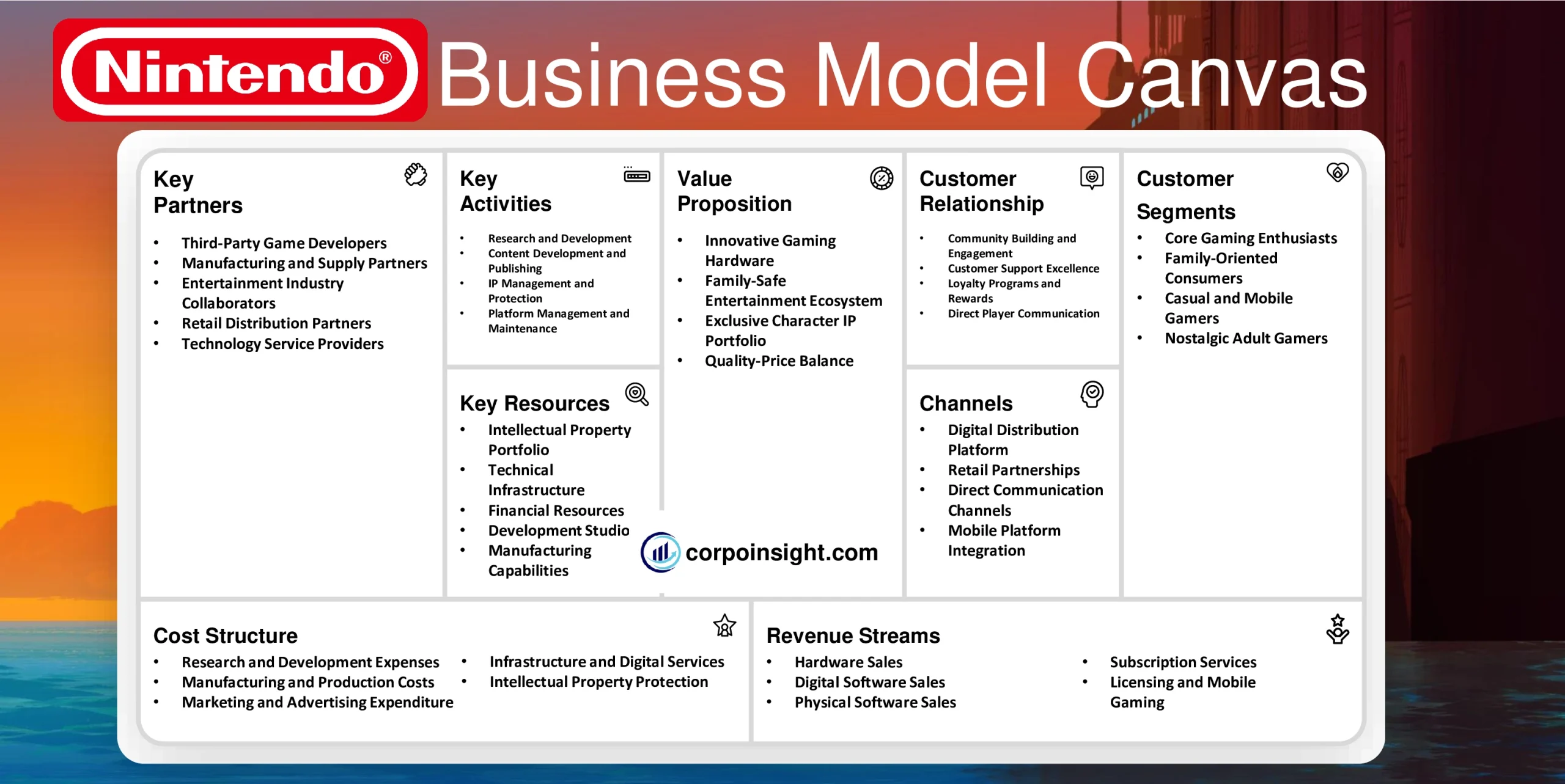
Conclusion on Nintendo Business Model Canvas
Nintendo’s business model canvas demonstrates a robust ecosystem built on innovative gaming experiences and cherished intellectual property. Through their hybrid hardware strategy, strong first-party content development, and strategic partnerships, they maintain industry leadership while fostering customer loyalty. Their conservative financial approach, coupled with diversification into mobile gaming and entertainment ventures, ensures sustainable growth, though they face increasing competition from digital platforms and evolving consumer preferences in the gaming industry.

This is Ahsanul Haque, someone very passionate about digital marketing, SEO, and Data Analytics and founder of the Analytics Empire and currently pursuing my major in marketing at Bangladesh University of Professionals.

